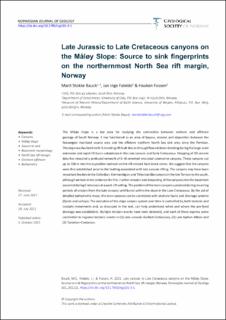Late Jurassic to Late Cretaceous canyons on the Måløy Slope: Source to sink fingerprints on the northernmost North Sea rift margin, Norway
Journal article, Peer reviewed
Published version

Åpne
Permanent lenke
https://hdl.handle.net/11250/2986098Utgivelsesdato
2021Metadata
Vis full innførselSamlinger
- Department of Natural History [297]
- Registrations from Cristin [9791]
Sammendrag
The Måløy Slope is a key area for studying the connection between onshore and offshore geology of South Norway. It has functioned as an area of bypass, erosion and deposition between the Norwegian mainland source area and the offshore northern North Sea sink area since the Permian. The slope was faulted into N–S-trending rift fault-blocks through flexural down-bending during the large-scale extension and rapid rift basin subsidence in the Late Jurassic and Early Cretaceous. Mapping of 3D seismic data has revealed a profound network of E–W-oriented erosional submarine canyons. These canyons cut up to 500 m into the crystalline bedrock on the rift-related fault-block crests. We suggest that the canyons were first established prior to the faulting associated with late Jurassic rifting. The canyons may have been important feeders in the Oxfordian, Kimmeridgian and Tithonian like canyons in the Uer Terrace to the south, although we lack direct evidence for this. Further erosion and deepening of the canyons into the basement occurred during Cretaceous in a post-rift setting. The position of the main canyons sustained during recurring periods of erosion from the Late Jurassic until burial within the slope in the Late Cretaceous. By the aid of detailed bathymetric maps, the main canyons can be correlated with onshore faults and drainage systems (fjords and valleys). The evolution of the slope canyon system over time is controlled by both tectonic and isostatic movements and, as discussed in the text, can help understand when and where the pre-fjord drainage was established. Multiple incision events have been detected, and each of these express some correlation to regional tectonic events in (1) Late Jurassic–Earliest Cretaceous, (2) Late Aptian–Albian and (3) Turonian– Coniacian.
